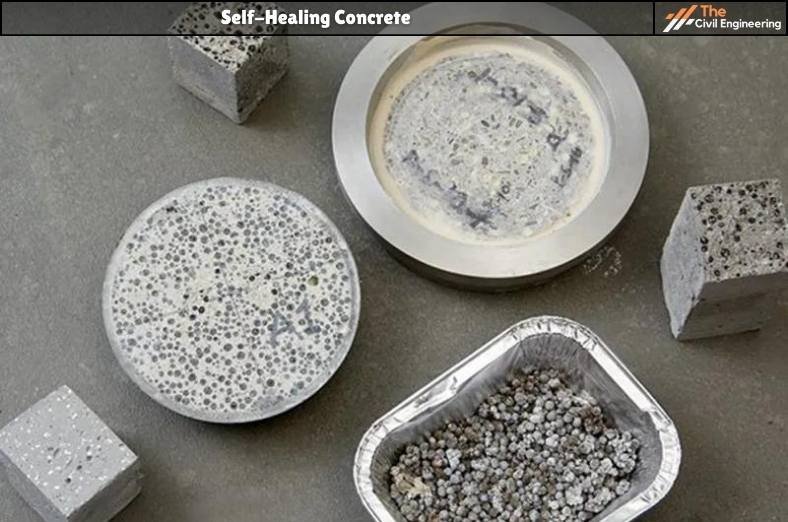Self-healing concrete is a special type of concrete that can repair its own cracks by the production of any kind of Material. Self-healing concrete is also named Bio-concrete.
Self-healing concrete is composed of three products. The healing agent is made in a 95% calcium lactate ratio to a 5% ratio of bacterial spores that are encapsulated within 2 to 4 mm wide clay pellets with separate nitrogen, phosphorous, and a nutrient.
It comes with 3 different products: self-healing concrete, a repair mortar, and a liquid repair medium. The cost price of this technology is very high, nearly about €30-40 (about $33-44) per square meter.
Self-healing of cracks in concrete will help to a longer life of concrete structures and will make the material more durable but also more sustainable.
Bacillus megaterium bacteria were used in concrete and results show a 24 percent improvement in compressive strength.
The deposition of calcium carbonate in concrete by Bacillus sphaericus increases the durability of concrete.
Bacteria are used for the purposes of Self-healing.
The bacteria from the Bacillus family is considered for self-healing in concrete. The following are those bacteria:
a. Bacillus Pastuerin
b. Bacillus Sphearicus
c. Bacillus Pseudofirmu
d. Bacillus Subtilia
1. History of Self Healing Concrete
Self-healing concrete was invented by microbiologist, and professor Henk Jonkers, at the Delft University of Technology in the Netherlands.
Jonkers started developing self-healing concrete in 2006. After taking three years of experimenting, he got the perfect healing agent which is bacillus.
Material Selection
1. Ordinary Portland Cement
2. Crushed aggregate of size 20 mm
3. Sand
4. Water
5. Calcium lactate (0.8%)
6. Bacillus subtilis (0.8%)
a. Characteristics of Bacillus
• Spores are 1-1.2 microns in diameter, round, and terminal to subterminal.
• The colonies are generally circular and glossy, however, the size and opacity increase from media to media.
• Urea-agar slant shows thin growth i.e. restricted and translucent.
• Urea-milk-agar streak plate shows variable hydrolysis of casein.
2. Need for Self-healing Concrete
The need for self healing concrete is as follows:
1. Small Cracks in a Structure are weak because water seeps in to degrade the concrete and corrode the steel reinforcement, which leads to structural failure.
2. It provides longer life to the structures.
3. Maintenance and repair are less required.
4. Improvement in compressive strength of concrete.
5. Reduction in permeability of reinforced concrete
6. Good resistance towards freeze-thaw attack reduction.
3. Applications of Self-healing Concrete
The self healing concrete is used in various sites such as:
1. Tunnel lining
2. Walls of the building
3. Highway bridges
4. Concrete floors
5. Structural Basement
6. Marines Structures
4. Working Process of Self-healing
In self-healing concrete when water seeps through the cracks, the bacteria get activated from its stage of dormancy and the bacteria start to feed on calcium lactate and in turn, produce calcium carbonate through its metabolic activities which act as a healing material.
1. Self-healing concrete is a substance that will biologically prepare limestone to heal cracks that comes on the surface of concrete structures.
Ca(C3HSO2)2 + 7 02 → CaCO3 + 5 CO2 + 5 H20
(Calcium Lactate) (Lime)
2. Especially, chosen types of the bacteria genus Bacillus, with a calcium-based nutrient given as calcium lactate, and nitrogen and phosphorus, are added to the ingredients of the concrete when it is being mixed.
5. Test on Self Healing Concrete
• In 2011, Jonkers and his team are doing testing and case studies on self-healing concrete.
• A tiny structure or part of a structure will be made with the self-healing material and watched over three to five years.
• Structures will be shaped with some panels of self-healing concrete and others with normal concrete so that the behavior of the two can be compared.
• Cracks will be built in concrete that is greater than the ones that have healed up in the laboratory to calculate how well and quickly they heal over time.
6. Properties of Self-healing Concrete
The properties governed by a Self Healing Concrete are as follows:
1. Workability
2. Surface Crack Healing
3. Compressive strength
8. Advantages of Self Healing Concrete
The advantages of self healing concrete are as follows:
1. Small Cracks in a Structure are weak because water seeps in to degrade the concrete and corrode the steel reinforcement, which leads to structural failure.
2. It provides longer life to the structures.
3. No need for periodical maintenance.
4. Improvement in compressive strength of concrete.
5. Reduction in permeability of reinforced concrete
6. Better resistance toward freeze-thaw attack reduction
9. Disadvantages of Self healing Concrete
The disadvantages of self-healing concrete are as follows:
1. Self-healing concrete cost price is almost 2 times compared to normal concrete.
2. Growth bacteria can be affected by various environmental conditions.
3. The clay pallets mixed in concrete mostly cover 20 % volume of concrete and This may result in a shear zone or fault zone in the concrete.
10. References1. Content Filter & Authenticity Checking Team, The Civil engineering (Our team checks every content & detail to maintain quality.) |
Read More: Trapezoidal footing
Read More: Rock Salt Finish Concrete

